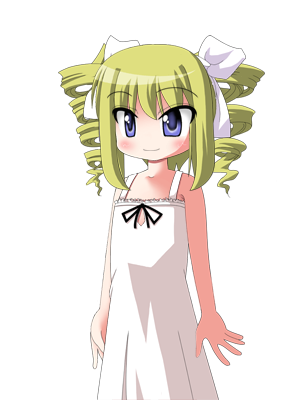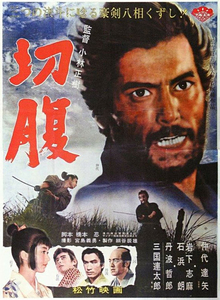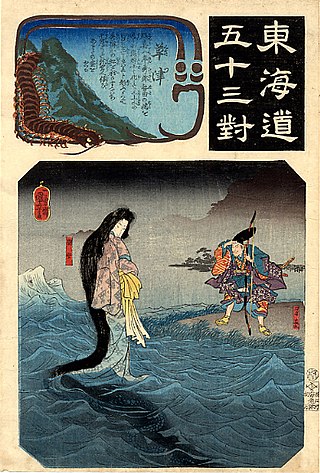
The revenge of the forty-seven rōnin, also known as the Akō incident or Akō vendetta, is a historical event in Japan in which a band of rōnin avenged the death of their master on 31 January 1703. The incident has since become legendary. It is one of the three major adauchi vendetta incidents in Japan, alongside the Revenge of the Soga Brothers and the Igagoe vendetta.

Sanjuro is a 1962 Japanese jidaigeki film directed by Akira Kurosawa and starring Toshiro Mifune. It is a sequel to Kurosawa's 1961 Yojimbo.

Tōhito, posthumously honored as Emperor Momozono, was the 116th emperor of Japan, according to the traditional order of succession. Momozono's reign spanned the years from 1747 until his death in 1762. Momozono's reign was mostly quiet, with only one incident occurring that involved a small number of Kuge who advocated for the restoration of direct Imperial rule. These Kuge were punished by the shōgun, who held de facto power in the country.
Kṣitigarbha is a bodhisattva primarily revered in East Asian Buddhism and usually depicted as a Buddhist monk. His name may be translated as "Earth Treasury", "Earth Store", "Earth Matrix", or "Earth Womb". Kṣitigarbha is known for his vow to take responsibility for the instruction of all beings in the six worlds between the death of Gautama Buddha and the rise of Maitreya, as well as his vow not to achieve Buddhahood until all hells are emptied. He is therefore often regarded as the bodhisattva of hell-beings, as well as the guardian of children and patron deity of deceased children and aborted fetuses in Japanese culture.

Chikamatsu Monzaemon was a Japanese dramatist of jōruri, the form of puppet theater that later came to be known as bunraku, and the live-actor drama, kabuki. The Encyclopædia Britannica has written that he is "widely regarded as the greatest Japanese dramatist". His most famous plays deal with double-suicides of honor bound lovers. Of his puppet plays, around 70 are jidaimono (時代物) and 24 are sewamono (世話物). The domestic plays are today considered the core of his artistic achievement, particularly works such as The Courier for Hell (1711) and The Love Suicides at Amijima (1721). His histories are viewed less positively, though The Battles of Coxinga (1715) remains praised.

Moe, sometimes romanized as moé or moe' in English, is a Japanese word that refers to feelings of strong affection mainly towards characters in anime, manga, video games, and other media directed at the otaku market. Moe, however, has also gained usage to refer to feelings of affection towards any subject.
Tamenaga Shunsui was the pen name of Sasaki Sadataka (佐々木貞高), a Japanese novelist of the Edo period.
Night on the Galactic Railroad, sometimes translated as Milky Way Railroad, Night Train to the Stars or Fantasy Railroad in the Stars, is a classic Japanese fantasy novel by Kenji Miyazawa written around 1927. The nine-chapter novel was posthumously published by Bunpodō (文圃堂) in 1934 as part of Complete Works of Kenji Miyazawa Vol. 3 (『宮沢賢治全集』第三巻). Four versions are known to be in existence, with the last one being the most famous among Japanese readers.

This is the glossary of Japanese history including the major terms, titles and events the casual reader might find useful in understanding articles on the subject.
Gangan is a manga imprint owned by Square Enix Holdings. It originated as a manga imprint for Enix before the company re-branded as Square Enix. It publishes manga in several anthologies aimed at different reader demographic groups in the Japanese market. Its anthologies are home to some popular Square Enix manga series which were adapted into anime series, like Fullmetal Alchemist, Moribito: Guardian of the Spirit, Nabari no Ou, Inu x Boku SS, The Case Study of Vanitas and Soul Eater. The comics are later collected in paperback volumes under brand names such as Gangan Comics, Gangan Comics Joker and Young Gangan Comics, which identify the anthology of serialisation. These paperback brand names are formed by omitting any gekkan or shōnen in the magazine name and inserting Comics directly after the word Gangan.

Harakiri is a 1962 Japanese jidaigeki film directed by Masaki Kobayashi. The story takes place between 1619 and 1630 during the Edo period and the rule of the Tokugawa shogunate. It tells the story of the rōnin Hanshirō Tsugumo, who requests to commit seppuku (harakiri) within the manor of a local feudal lord, using the opportunity to explain the events that drove him to ask for death before an audience of samurai. The film continues to receive critical acclaim, often considered one of the best samurai pictures ever made as well as one of the greatest films ever made.

Yukio Ozaki was a Japanese politician of liberal signature, born in modern-day Sagamihara, Kanagawa. Ozaki served in the House of Representatives of the Japanese Diet for 63 years (1890–1953). He is still revered in Japan as the "God of constitutional politics" and the "father of the Japanese Constitution".
Chūshingura is the title given to fictionalized accounts in Japanese literature, theater, and film that relate to the historical incident involving the forty-seven rōnin and their mission to avenge the death of their master, Asano Naganori. Including the early Kanadehon Chūshingura (仮名手本忠臣蔵), the story has been told in kabuki, bunraku, stage plays, films, novels, television shows and other media. With ten different television productions in the years 1997–2007 alone, Chūshingura ranks among the most familiar of all historical stories in Japan.
Japanese detective fiction, is a popular genre of Japanese literature.

The Tale of Tawara Tōda is a Japanese heroic tale recounting the legendary exploits of Fujiwara no Hidesato. It is part of the otogi-zōshi genre of tales dating to the Edo Period or earlier. Some of the fabulous accounts are also told in the military pseudo-chronicle, Taiheiki.
The Treasury of Loyal Retainers is an 11-act bunraku puppet play composed in 1748. It is one of the most popular Japanese plays, ranked with Zeami's Matsukaze, although the vivid action of Chūshingura differs dramatically from Matsukaze.

Seppuku, also called harakiri, is a form of Japanese ritualistic suicide by disembowelment. It was originally reserved for samurai in their code of honour, but was also practised by other Japanese people during the Shōwa era to restore honour for themselves or for their families.
Forty-seven Ronin refers to a case involving the samurai code of honor.

When Supernatural Battles Became Commonplace aka InoBato is a Japanese light novel series written by Kōta Nozomi with illustrations by 029. SB Creative has published it in thirteen volumes from 2012 to 2018 under their GA Bunko imprint. A manga adaptation with art by Kōsuke Kurose was serialized in Kadokawa Shoten's Comp Ace from September 2013 to February 2015 and compiled in four volumes. A 12-episode anime television series adaptation by Trigger aired between October and December 2014.
Masahiko Matsumoto was a Japanese manga artist. He is considered a pioneer of alternative manga through his incorporation of cinematic techniques into manga from the mid-1950s onward. His style known as komaga, together with the manga of Yoshihiro Tatsumi and Takao Saito, was the catalyst of the gekiga movement.











